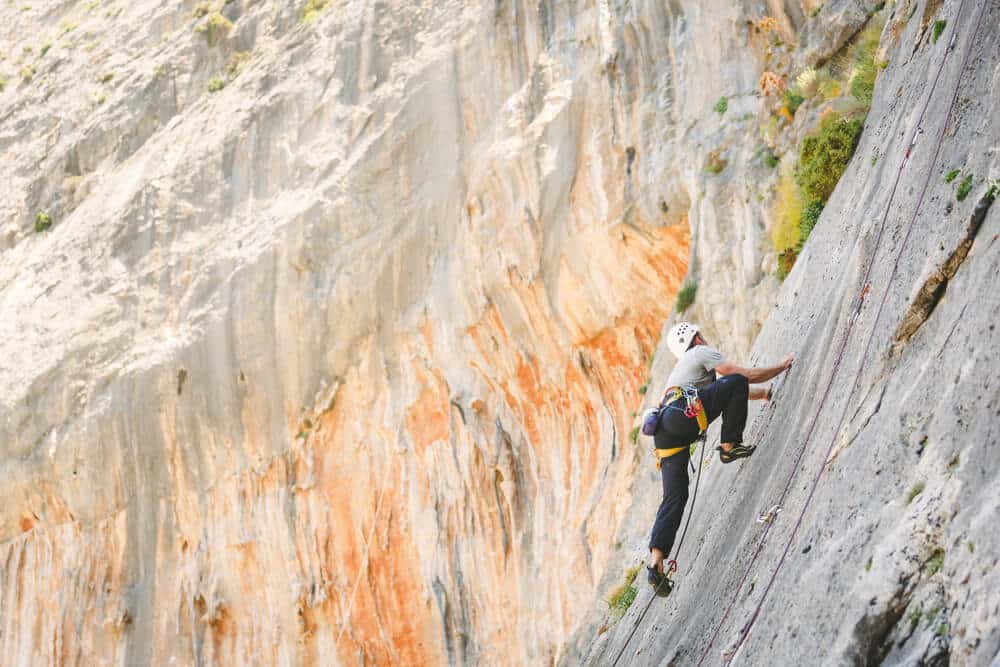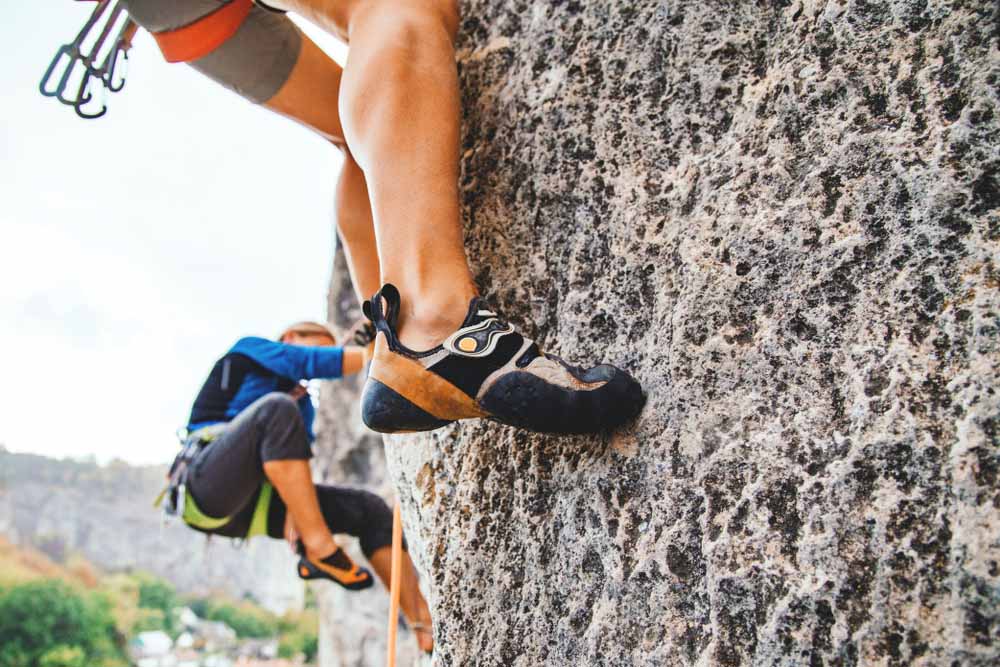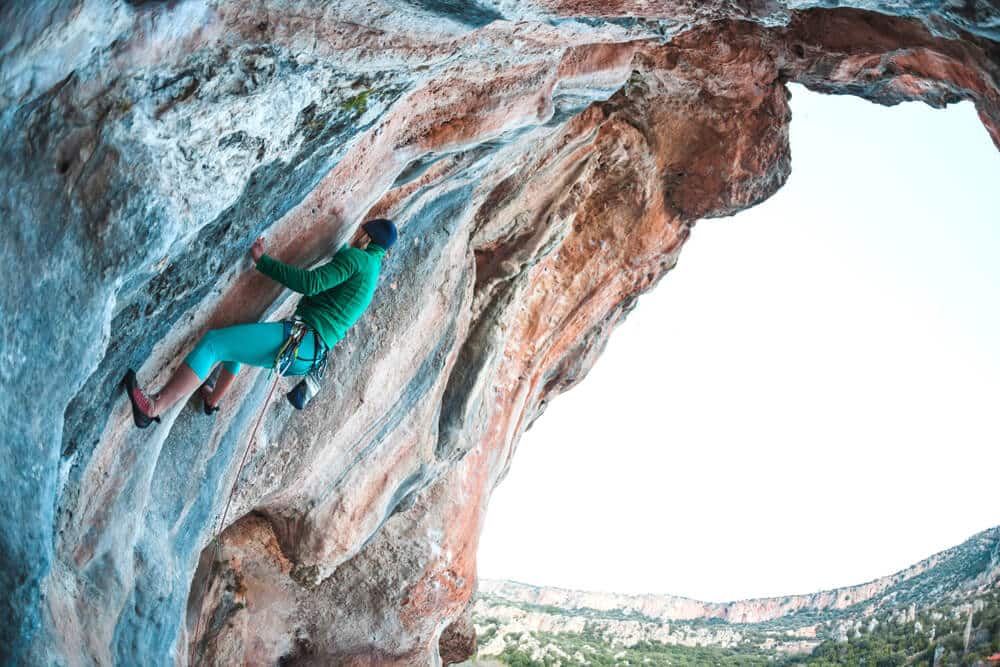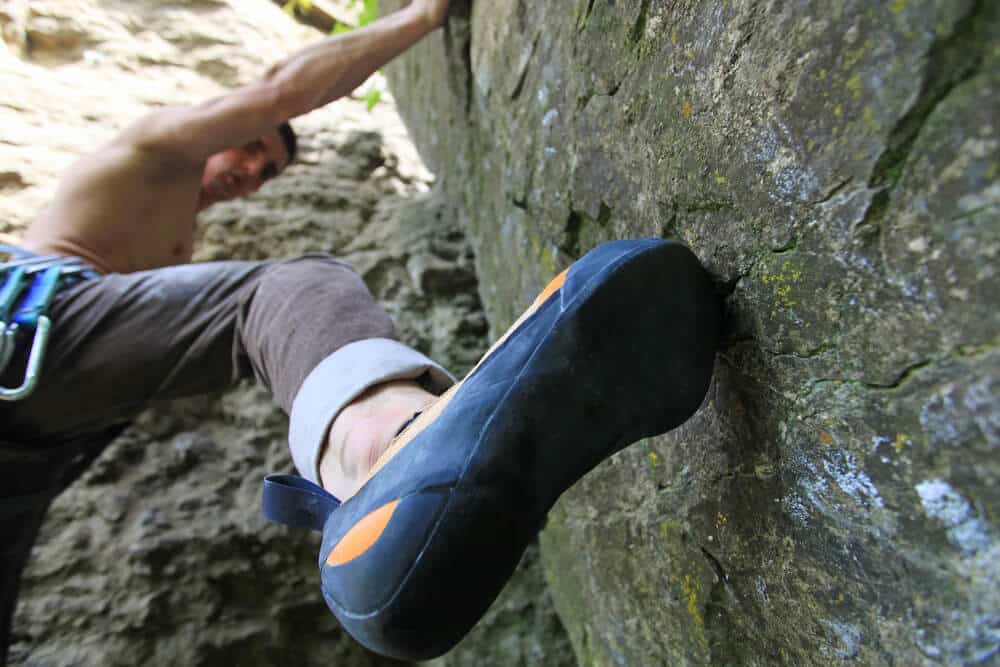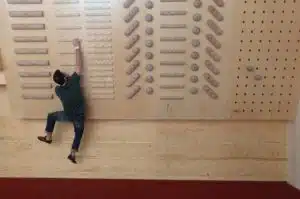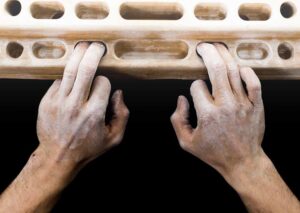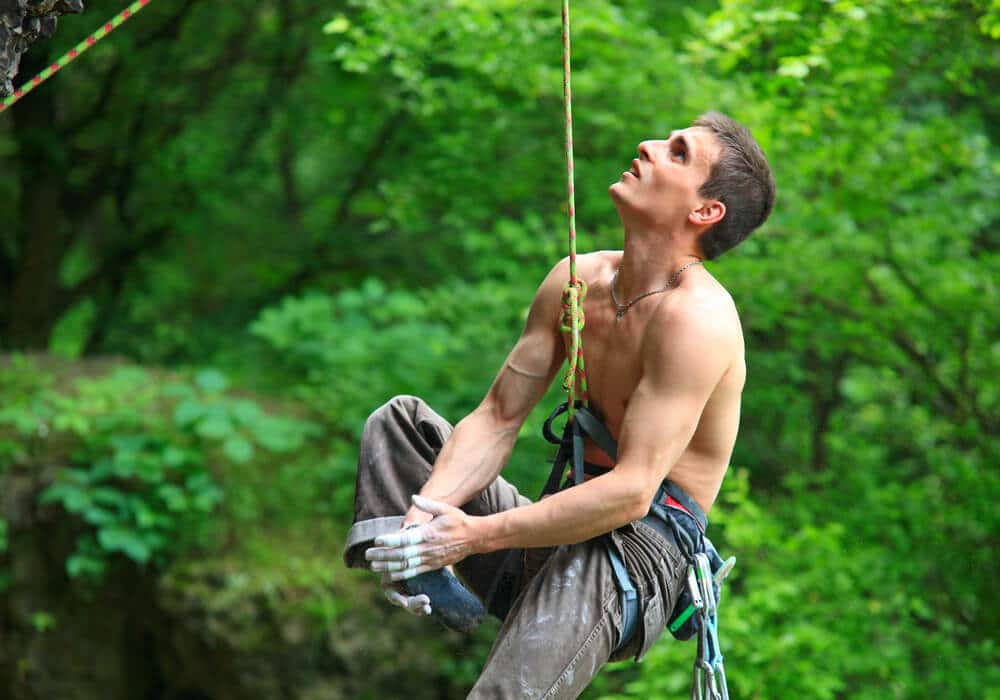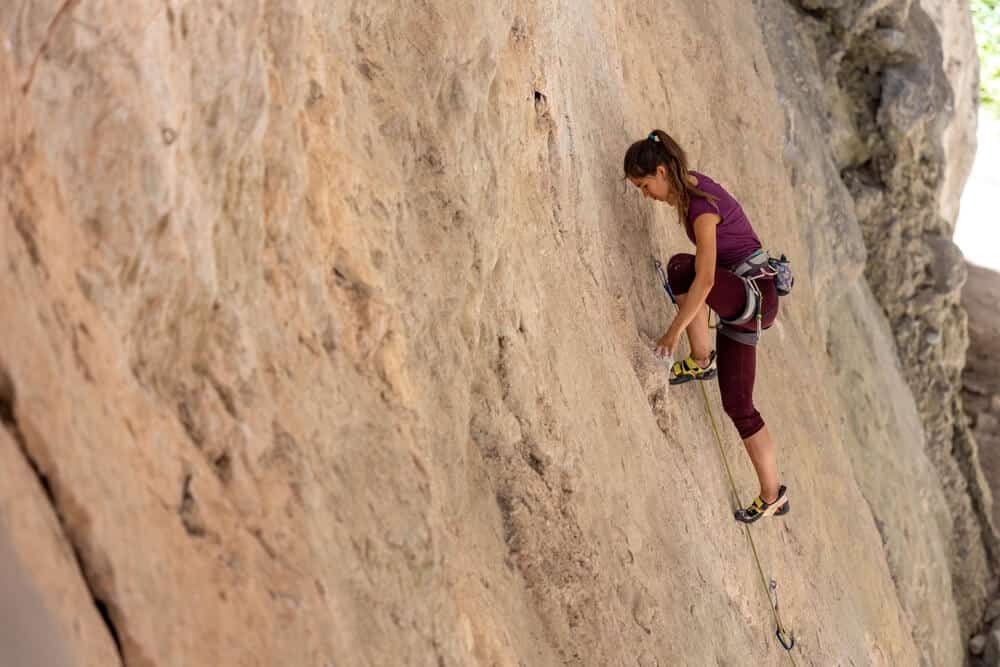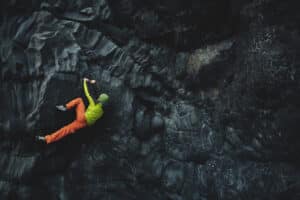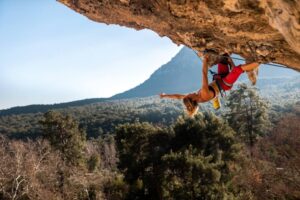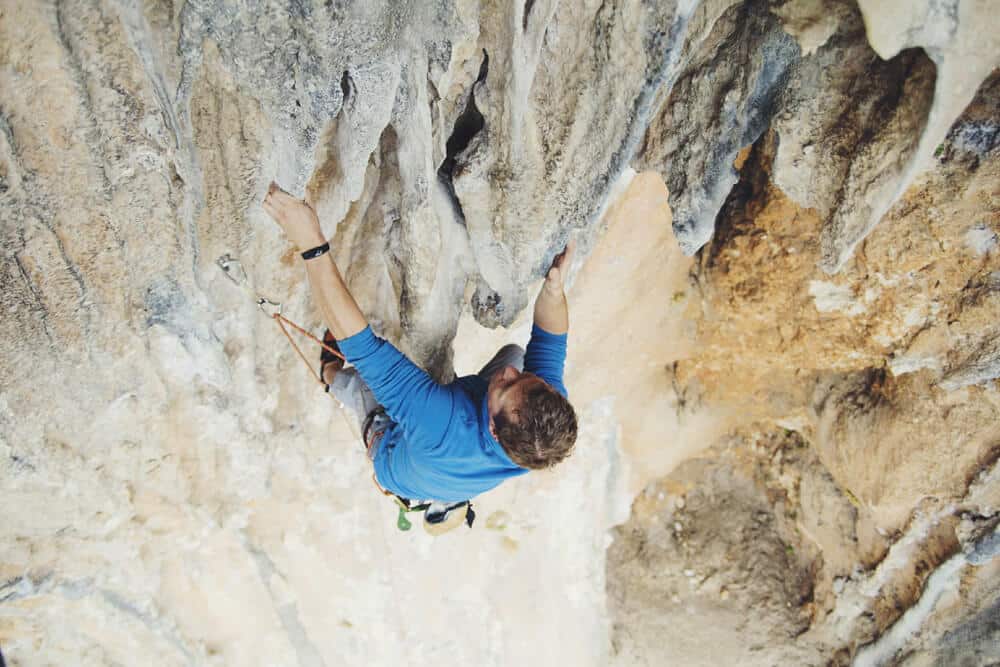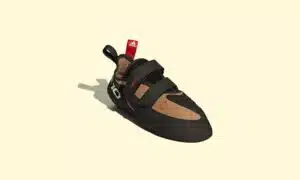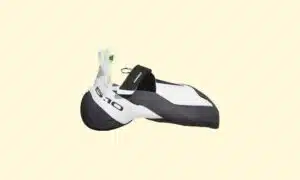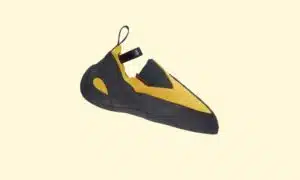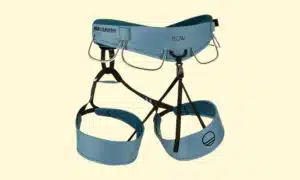After reading a word like “smearing,” you might assume this article is going to delve into the world of spreadable cream cheese toppings for bagels. However, that would be “schmear.” Smearing in climbing is much different (however, for the linguists out there, I will include a short aside about how smear and schmear might be related).
Smearing in rock climbing is a friction-based technique where you place the flat rubber sole of your climbing shoes directly onto the rock instead of a reliable edge or better foot placement.
Keep reading to learn more about this important technique. Below, I will discuss what smearing is, how to smear, and some considerations for learning and perfecting the smear climbing technique.
Note: This post is part of a wider series on climbing technique, which also include:
What is smearing in rock climbing?
Smearing is a rock climbing technique where you place the sole of your climbing shoe flat against the rock wall. When placing a smear or smearing, you rely solely on the friction created between the sticky rubber of your climbing shoes and the rock.
Smearing vs. Edging
If there was a spectrum of climbing footwork techniques, smearing would be on one side, and edging would be on the far opposite side. However, that does not mean that one is more important or better than the other. Being able to fluidly use both climbing techniques is essential to a well-rounded climber.
For the most part, smearing is a much different technique than edging. Nonetheless, there are some similarities also.
Where to Smear while Climbing Outdoors
Technically speaking, you can smear anywhere. In fact, the more comfortable you are with smearing onto the wall, the better climber you’ll become.
However, smearing is, by and large, a climbing technique that you deploy in low-angle slab climbing. In other words, smearing is ideal on less-than-vertical walls. That is because low-angle terrain can be characteristically less featured. Plus, it’s more comfortable and ergonomic for your body.
You can smear on any type of rock. However, when I think of where I deploy smearing techniques, I think of granite and sandstone slab climbs. Oftentimes, the rough rock surface of granite and sandstone formations, along with the low-angle, lends itself nicely to creating friction with my shoe’s rubber.
How to Smear
At first glance, smearing is a relatively straightforward and easy-to-learn climbing technique. In fact, I frequently notice beginner climbers smearing all over the place. However, I do not think they know what they are doing or are intentionally doing it. Most often, they are desperately placing their feet wherever they can to help propel them upwards.
Nonetheless, the technique is quite intuitive and natural. However, perfecting the technique and deploying it on hard climbs with confidence takes a lot of practice and experience.
-
Leading with your big toe, make a precise foot placement, looking for micro features that can help increase friction.
-
After placing your smear, press down through your legs and toes, engaging the rubber.
-
Drop your heels down towards the ground to increase surface contact.
-
To move off the smear, maintain balance, press into the smear, and stand up slowly and controlled, avoiding a rapid transition.
-
Repeat the smearing technique
Lead with Your Big Toe
Even though you are not edging, accuracy still matters when smearing. Therefore, like always, you want to lead with the big toe. Place your smear with accuracy and confidence in the location that best supports your body weight or prepares you to make the next move.
Most times, you smear with your foot in line with the wall in a vertical orientation. Meaning your toes should be facing upwards and your heels should be pointed to the ground. However, in particularly low-angle terrain, smearing horizontally is also an effective way to balance and move upwards.
Keep Heels Low
After making a precise foot placement with the sole of your climbing shoe, drop your heel down towards the ground. Press down through your foot, straightening your leg. Dropping your heels puts more of your shoe’s rubber in contact with the rock.
Drop Your Body Weight into Your Feet
This is easier said than done, but with more weight on your feet, your foot placement will feel more reliable.
Climbing too close to the wall with your hips will prevent you from relaxing your upper body and dropping your heels. On the other hand, climbing in a crouched position or with your butt and hips too far from the wall will pull you off.
After you place your feet, and as you are focusing on dropping your heels into place, imagine sagging into the position. Straighten your arms and relax them as much as possible. Keep the bulk of your body weight positioned above your feet. When possible, keep your feet shoulder-width apart and trust the shoe rubber.
Nuances to Smearing Technique
In most cases, a smear is a smear. You place your feet flat on the wall, press down through your heels, trust the rubber, and stand up. But there are two other smear-like foot placements I think are important and want to mention.
Smedging: smedging is a mixture of smearing and edging. It’s when your foot placements are mostly friction-dependent smears, but with a little edge to help increase friction. With a smedge, the edge is not big enough to actually use an edging technique. Therefore, you still want to use of the sole of your foot to smear into the wall, including the small edge.
As the name suggests, smudges are great on edges. However, you can smedge on any micro-feature, like crystals, dimples, chickenheads, cracks, or dishes.
Shmornering: in a lot of climbing circles, smedging is an agreed upon and talked about technique. However, shmornering might be something I made up.
It’s when you smear your climbing shoe into a crack-less corner system. When shmornering, you rely on friction from three points of contact– the sole, the inside rand, and outside rand.
Because there is no crack, shmornering is not like foot or toe jamming. Instead, it’s a purely friction-dependent 3-D version of smearing in a corner, not a flat, 2-D wall.
Common Smearing Mistakes
Forgetting to Keep Heels Low
If you need to smear and you don’t drop your heels, you are essentially just edging. Depending on the placement, this will not suffice, and your foot will pop off. This is especially true for smears on steeper terrain. The steeper the rock surface, the more important it is to drop your heels and press hard into the smear.
Wearing the Wrong Shoe
Flat out– some climbing shoes are better at smearing than others. In particular, shoes with a flatter and symmetrical shape tend to lend themselves to smearing better than downturned shoes. In addition, I tend to think that softer, more flexible shoes are better at smearing.
So if you are wearing a stiff, downturned edging shoe that thrives in steep, overhung, bouldery terrain like the La Sportiva Solution and trying to smear your way up a slab climb, you may not be deploying the most appropriate tool for the terrain.
Not looking for Micro Features in the Rock
In its purest form, a smear is a foot placement on otherwise featureless rock where you rely solely on friction to keep your foot from slipping. Therefore, it’s common for climbers to simply slap their foot on the wall and hope for the best when they don’t see any obvious footholds.
However, in reality, whenever you smear, it’s critical to place your foot on whatever micro feature(s) possible to create friction. Little crystals, dimples, divots, edges, cracks, seams, and ripples all go a long way in helping you smear.
Taking big steps
Beginner slab climbers love to make high steps because they believe that that’s the shortest way between the ground and the top of the climb. However, when you are maintaining balance on a slab, big steps are harder– they require more leg strength and more dynamic movement.
Instead, I always preach to make baby steps. Small controlled movements give you better balance and give you enough friction to stick to the wall.
Considerations for Smearing
-
Trust your foot to stick. Good technique will only get you so far. When it comes to desperate smears, a certain amount of trust (and luck) is required to keep your feet on the rock.
-
Ensure your rubber sole is clean. Debris from the ground is great at reducing friction and the surface area between the sticky rubber outsole of your shoe and the rock. Smearing with dirty climbing shoes is like climbing on tiny ball bearings.
-
Maintain positive pressure. The more pressure, the more rubber. As you maintain balance and search around for your next handhold while standing on featureless smears, remind yourself to apply pressure through your feet.
-
Wear soft shoes- or don’t, it’s preference. My personal preference is to climb slabs with soft shoes. However, other seasoned slab climbers may argue that stiff shoes give you more friction. You’ll need to develop your own preference by rock climbing a lot. Regardless, don’t use an aggressively downturned shoe.
-
Colder temperatures are better. Rock climbing, in particular slab climbing, is way more fun in colder weather. That’s because your skin and shoe rubber have more friction when the rock face and ambient temperature are cold. So, probably don’t jump on your slab mega-project when it’s hotter than hell outside.
How to Practice Smearing Effectively
The best way to get better at smearing climbing techniques, like classic smearing, smedging, and shmornering, is to go out and smear everything.
-
Climb an easy route in approach shoes. Most approach shoes are not wonderful at edging but they still have sticky rubber on the outsole. That makes approach shoes great for practicing smearing.
-
Climb on jugs and bad feet. At the bouldering wall in your gym, pick out an easy climb with good handholds and attempt it without footholds. Instead, smear your feet directly on the wall.
-
Work on ankle mobility. The better your ankle is at dorsiflexion and plantarflexion, the better you’ll be able to get into an effective smearing body position and feel secure on a blank rock face.
For the linguists –Did you say schmear or smear?
According to the Merriam-Webster dictionary, “schmear” is a layer of food or condiment. However, before schmear was modernized to encapsulate any spreadable food condiment, like cream cheese or butter, it had a more literal Yiddish meaning, originating from the word shmirm, which means to spread food on something.
Similarly, the modern word schmear has Germanic roots. The word schmieren has the same meaning as the Yiddish shmirm. And is similar to the German academic translation for cream cheese, which is schmierkaese.
All linguistics aside– if all you remember from this article is schmearing the outsole of your climbing shoe on the wall like cream cheese helps create a solid smear, then I’ve done my job.
Final Thoughts– If You Can Gain Confidence Smearing, You Can Climb Anywhere
For many new climbers, smearing is an intuitive technique they deploy almost naturally when they cannot find obvious footholds and are desperately looking for foot placements to avoid losing balance. Over time, as their footwork improves, they learn that besides accurately placing their feet on edges with precision, smearing is one of the most essential climbing techniques.
In fact– I argue that smearing is a climbing technique that beginners should learn early.
That’s because smearing helps you create friction on otherwise featureless rock. If you can climb confidently with your feet on featureless rock, you can climb anywhere. Then, when there are small footholds to work with, you’ll feel right at home, trusting your feet.


